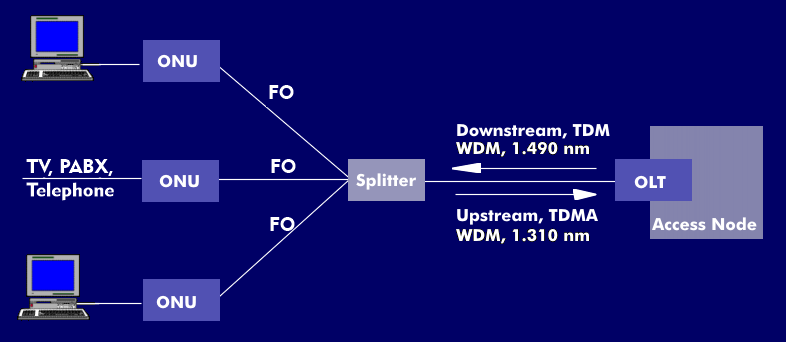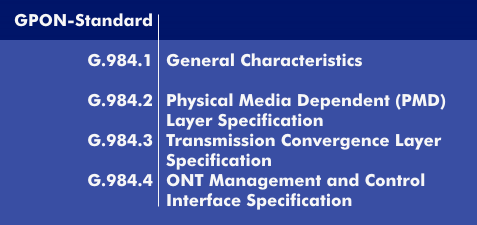gigabit PON (GPON)
GigabitPON (GPON) is an FTTx technology based on passive optical networks ( PON), which is characterized by transmission rates of 2.5 Gbps. GPON technology competes with Ethernet Passive Optical Network( EPON) and with Gigabit Ethernet PON( GEPON), with GPON being preempted in Europe and the US
GPON uses generic encapsulation( GEM), which allows Ethernet frames and data to be transmitted over a GPON link. A GPON link operates unidirectionally in the downstream and upstream. In the downstream, data is transmitted to customers in the exchange using time division multiplexing(TDM); in the upstream, customers send data using TDMA in allocated time slots.
A GPON connection is a point-to-point connection. The fiber outgoing from the access node( AN) in the exchange is laid in empty conduits and terminated with an optical line termination( OLT). The single mode fiber is routed over an optical splitter where it is split for multiple signal paths. The splitter, which operates passively, distributes the optical fibers to the connection points formed by the optical network unit( ONU). Downstream, the splitter routes the transmitted signal to the end users through its 32 or 64 outputs, such that all end users receive the same signal. In the upstream, the splitter routes the individual customer signals only in the direction of the exchange. To ensure that the downstream and upstream are separate and do not interfere with each other, GPONs operate at two different wavelengths: The downstream is transmitted at the wavelength of 1,490 nm, the upstream at 1,310 nm. If transmission takes place on two optical waveguides, then both operate at 1,310 nm.
GPON in contrast to BPON
Unlike Broadband Passive Optical Network( BPON), GPON can transmit data rates in the gigabit range in both directions. For example, ITU Recommendation G.984 defines transmission rates of 1.244 Gbit/s and 2.488 Gbit/s for the downstream, while the upstream is supported at speeds of 622 Mbit/s and 1.244 Gbit/s over 20 km. The International Telecommunication Union (ITU) is working on higher access rates with 10 Gbit/s bidirectional over 20 km. The further development can be seen in 10GEPON based on 10 Gigabit Ethernet.
GPON is realized in SFP modules. There are two different versions, called Classes, which differ in the optical budget. Class B+ has a transmit power between 1.5 dB and 5 dB and a receive sensitivity of 28 dB. Class C+ modules have values of 3 dB to 7 dB and 32 dB. The ITU has defined separate wavelengths for the transmission of video. However, since video signals can also be transmitted via GPON using the IP protocol, it is conceivable that the wavelengths intended for this purpose remain unused.


